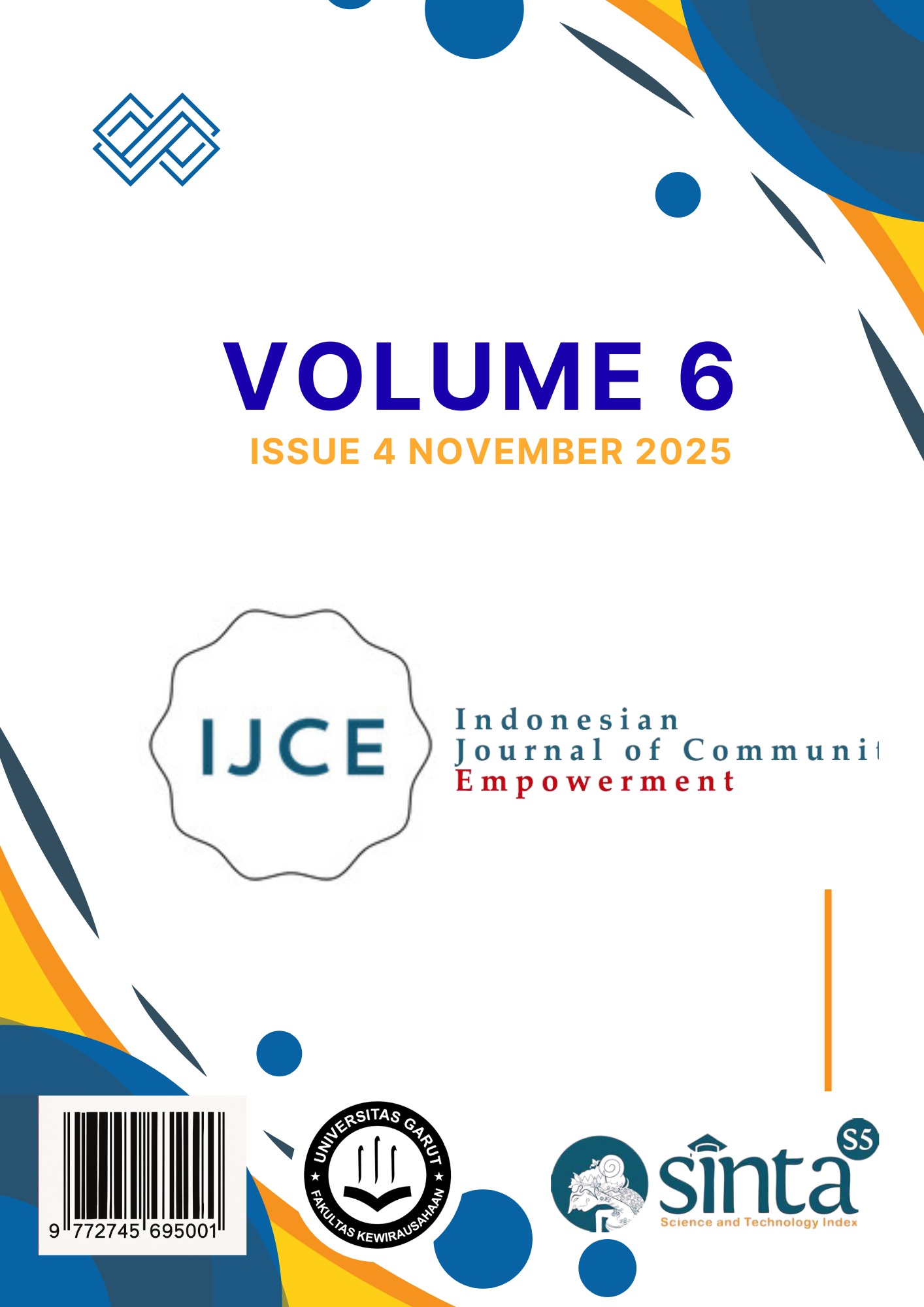THE EFFECTIVENESS OF BULLYING PREVENTION EDUCATION ON IMPROVING STUDENTS' UNDERSTANDING AT SDN 1 NEGLASARI
Abstract
ABSTRACT
Bullying is an intentional and repetitive aggressive behavior, whether verbal, physical, or social, that negatively impacts the victim’s psychological condition. This study aimed to evaluate the effectiveness of bullying prevention education in improving students’ understanding at SDN 1 Neglasari. The research employed a descriptive quantitative approach with 59 respondents from fifth and sixth grade. Data were collected through pre-tests, post-tests, and written accounts of personal or peers’ experiences related to bullying. The results showed an increase in students’ understanding from 71.86% to 89.10%, with the highest improvement in verbal and physical bullying. Students’ written experiences revealed that verbal bullying was the most frequently encountered (39%), followed by physical and social bullying, while 44% of students reported never experiencing bullying. Bullying prevention education proved effective in enhancing students’ understanding and serves as a preventive effort to create a safe and child-friendly school environment.
ABSTRAK
Perundungan merupakan perbuatan yang dilakukan secara terus menerus dan bersifat agresif, mulai dari verbal, fisik, maupun sosial, yang berdampak negatif pada kondisi psikologis korban. Penelitian ini bertujuan mengevaluasi efektivitas edukasi pencegahan bullying dalam meningkatkan pemahaman siswa SDN 1 Neglasari. Metode penelitian menggunakan pendekatan kuantitatif deskriptif dengan 59 responden kelas lima dan enam. Data dikumpulkan melalui pre-test, post-test, serta penulisan pengalaman pribadi atau teman terkait bullying. Hasil menunjukkan peningkatan pemahaman siswa dari 71,86% menjadi 89,10%, dengan peningkatan tertinggi pada bullying verbal dan fisik. Pengalaman tertulis siswa mengungkapkan bullying verbal paling sering dialami (39%), diikuti fisik dan sosial, sementara 44% siswa tidak pernah mengalami bullying. Edukasi pencegahan bullying terbukti efektif meningkatkan pemahaman siswa dan menjadi upaya pencegahan untuk menciptakan lingkungan sekolah yang aman.
References
M. Yudistira Nugraha and M. Sirozi, “Strategi Tindakan Kekerasan dan Bullying di Sekolah: Bentuk, Pelaku dan Pencegahannya,” J. Pendidik. dan Teknol. Indones., vol. 5, no. 3, pp. 881–885, 2025.
A. D. Makrufi, N. F. Aliza, and H. Tahang, “Edukasi pencegahan tindak perundungan (bullying) pada siswa sekolah dasar,” Hayina, vol. 3, no. 1, pp. 27–35, 2023, doi: 10.31101/hayina.3278.
J. M. Beaton, W. J. Doherty, and L. M. Wenger, “Mothers and fathers coparenting together,” Routledge Handb. Fam. Commun., pp. 225–240, 2012, doi: 10.4324/9780203848166.
C. N. K. Dany, F. Adinda, P. S. Harahap, A. R. N. Fachira, and P. A. Siregar, “Antisipasi Kesehatan Mental Melalui Pencegahan Bullying Di Smpn 31 Kota Medan,” Community Dev. J. J. Pengabdi. Masy., vol. 6, no. 1, pp. 937–942, 2025, doi: 10.31004/cdj.v6i1.41714.
N. A. Hamdani, V. Ramadani, G. Anggadwita, and ..., “Gender stereotype perception, perceived social support and self-efficacy in increasing women’s entrepreneurial intentions,” … Entrep. …, 2023, doi: 10.1108/ijebr-02-2023-0157.
D. H. Permatasari, S. Fitriana, and A. Ariswati, “Tingkat Penyesuaian Diri Siswa di SMK Negeri 2 Semarang,” J. Wahana Konseling, vol. 7, no. 2, pp. 248–254, 2024, doi: 10.31851/juang.v7i2.15038.
S. A. Visty, “Dampak Bullying Terhadap Perilaku Remaja Masa Kini,” J. Interv. Sos. dan Pembang., vol. 2, no. 1, pp. 50–58, 2021, doi: 10.30596/jisp.v2i1.3976.
N. Simatupang, “Bullying Oleh Anak Di Sekolah Dan Pencegahannya,” J. Ilmu Huk., vol. 6, p. 446, 2021, doi: 10.30596/delegalata.v6i2.5057.
F. Erkurnia, T. N. Putri, Y. N. Dianningsih, and I. Rachmawati, “Analisis Profil Perilaku Bullying Pada Siswa Tingkat Sekolah Dasar Negeri Di Kabupaten Bantul,” G-Couns J. Bimbing. dan Konseling, vol. 8, no. 3, pp. 1254–1259, 2024, doi: 10.31316/gcouns.v8i3.5059.
E. Emilda, “Bullying di Pesantren: Jenis, Bentuk, Faktor, dan Upaya Pencegahannya,” Sustain. J. Kaji. Mutu Pendidik., vol. 5, no. 2, pp. 198–207, 2022, doi: 10.32923/kjmp.v5i2.2751.
A. P. Adellia, S. Sulistiyana, and H. Y. S. Putro, “Studi Komparatif: Bullying di Dunia Nyata dan Dunia Maya (Cyberbullying),” Edukatif J. Ilmu Pendidik., vol. 6, no. 4, pp. 4000–4007, 2024, doi: 10.31004/edukatif.v6i4.7240.
G. A. F. Maulani and T. M. Sapril Mubarok, “Analisis Pengaruh Teknologi Informasi Pada Iklim Organisasi Dan Dampaknya Terhadap Komitmen Organisasi Perguruan Tinggi Swasta,” J. Civ. Soc. Stud., vol. 4, no. 2, pp. 12–24, 2020, doi: 10.31980/civicos.v4i2.912.
F. A. Sofyan, C. A. Wulandari, L. L. Liza, L. Purnama, R. Wulandari, and N. Maharani, “Bentuk Bullying Dan Cara Mengatasi Masalah Bullying Di Sekolah Dasar,” J. Multidisipliner Kapalamada, vol. 1, no. 04, pp. 496–504, 2022, doi: 10.62668/kapalamada.v1i04.400.
N. A. Hamdani, R. Muladi, G. Abdul, and F. Maulani, “Digital Marketing Impact on Consumer Decision-Making Process,” vol. 220, no. Gcbme 2021, pp. 153–158, 2022.
A. Dahlena and E. Mulyana, “Eksistensi Social Behavior Dalam Pembelajaran IPS Sebagai Penguatan Keterampilan Peserta Didik di Abad-21,” Soc. Sci. Educ. Res., vol. 2, no. 1, pp. 2774–2776, 2021.
S. Damayanti, K. Suryadi, and S. W. Tanshzil, “School Climate and Bullying Prevention A Civic Education Perspective,” J. Educ. Res., vol. 5, no. 4, pp. 4980–4990, 2024, doi: 10.37985/jer.v5i4.1369.
A. Dahlena, R. Septiani, A. Adiansyah, E. Mulyana, and G. A. Fatah, “Becoming a Smart User in the Social Media Era,” Indones. J. Community Empower., vol. 5, no. 3, pp. 160–165, 2024.
B. J. Purba, “Journal of social, justice and policy 34,” vol. 1, no. 1, pp. 34–41, 2022.
A. A. Handayani and F. Falah, “Bullying Prevention in Schools: Evaluating Social, Economic, and Technological Interventions,” J. Heal. Lit. Qual. Res., vol. 3, no. 2, pp. 85–98, 2023, doi: 10.61194/jhlqr.v3i2.529.













